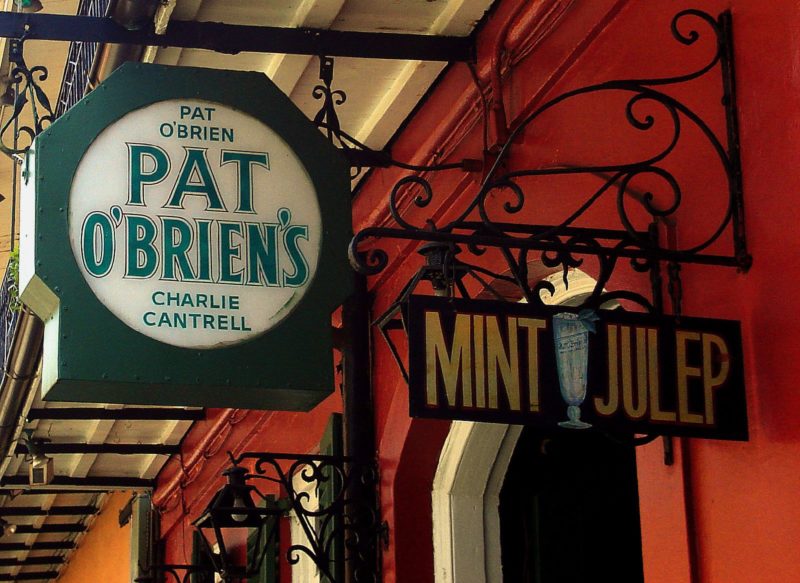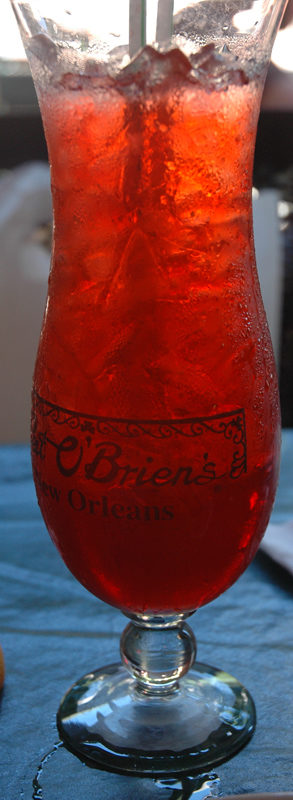
Pat O’Brien’s modest yet distinctive sign. Photo by Kate Peregrinate via Flickr.
Editor’s Note: Bourbon street, like New Orleans, is a place like no other. Anything goes in this iconic street; it has often been referred to as “the life of a party town” and “a place for revelry of all sorts”. It appears as if even the most erratic behaviors are legal there. In Bourbon Street partygoers have liberties like open-container drinking and public nudity, which are illegal everywhere else. The street has a never-ending selection of bars and restaurants with different music genres and themes that cater to even the most unique of tastes. The liberties allowed on Bourbon Street often bring to mind the question of “How is this legal?” and have given New Orleans a wild reputation. Famous musicians like Mannie Fresh attest to this reputation saying, “When a lot of people are calling it a night at 2 AM, New Orleans is coming alive,” comments such as these have made New Orleans nightlife iconic. People travel across the country to come let loose and lose their inhibitions in Bourbon Street, especially during Mardi Gras when the city sees an influx of approximately 1.4 million people. The party reputation of New Orleans and the spotlight placed has brought many benefits like tourism to the state but has also resulted in a lack of attention towards more serious issues. New Orleans has deeply entrenched issues regarding its prison system and inequalities with race. Preoccupying stories about how women in the Orleans parish prison can get sterilized to reduce their prison sentence and how prison labor is comparable to slavery don’t get half the attention of stories about the best bars in Bourbon. It would be useful to open people’s eyes to the realities of New Orleans and give attention to the issues that need resolving shifting from people asking, “How is this legal?” to “How is this not illegal?”. This piece was originally published on August 1, 2017.
Pat O’ Brien’s is a unique bar in New Orleans, Louisiana. Located right at home on Bourbon Street, it’s one of the most commonly visited bars in the French Quarter. The bar has always been significant to the culture of New Orleans, serving as a signal of the end of prohibition for the booze-loving town in 1933 when Pat O’Brien converted his speakeasy into a drinking establishment in the 600 block of St. Peter. When Pat realized how little space he had, he moved the bar to 718 St. Peter Street where it still sits today. It’s ideal location paired with it’s lively atmosphere has kept the customers coming and the drinks pouring ever since.

Pat O’Brien’s signature drink: The Hurricane. Photo by Angela on Flickr.
Their success is readily visible. Tourists and locals alike stroll the quarter with the distinctive Hurricane cups, easily downing the violently red liquid within. The Hurricane (recipe here) was created in World War II, when whiskey was sparse but rum was plentiful. With all the rum in the bar and a few empty hurricane lamps, history was made (Keith I. Marszalek, “Home of the ‘Hurricane’ Pat O’Brien’s turns 75 this week.” NOLA.com. November 30, 2008. Accessed July 05, 2017). The improvisation was successful enough that Pat O’Brien’s now-famous drink hasn’t changed in composition since: light rum, dark rum, a few different fruit juices, and a dash of grenadine.
The result is something sickly sweet and slightly tropical. For those who prefer this knock-out in the comfort of their own homes Pat O’Brien’s also sells a drink mix. But somehow, a Hurricane on your own is never quite the same as one served in an imposing glass in the bar’s bustling crowd.
 NOLAbeings Multimedia artist Claire Bangser created NOLAbeings as a portrait-based story project that marries...
NOLAbeings Multimedia artist Claire Bangser created NOLAbeings as a portrait-based story project that marries...  Voodoo in New Orleans: Reviving history: New Orleans fortune telling This article takes a deep dive into the history of Voodoo in New Orleans, its hybridization with Catholicism, and its present-day place in the city's culture. The author visits fortune-tellers in the French Quarter, using their guidance as a tool for introspection rather than a deterministic predictor of the future. Through her experiences in New Orleans, the author feels a mystical connection to both the past and the future.
Voodoo in New Orleans: Reviving history: New Orleans fortune telling This article takes a deep dive into the history of Voodoo in New Orleans, its hybridization with Catholicism, and its present-day place in the city's culture. The author visits fortune-tellers in the French Quarter, using their guidance as a tool for introspection rather than a deterministic predictor of the future. Through her experiences in New Orleans, the author feels a mystical connection to both the past and the future. 